The Cornell Lab Bird Academy › Discussion Groups › Joy of Birdwatching › Activities: Exploring Birds
-
1. I played around with the Wall of Birds interactive for some time. I loved getting to see the long "eyebrows" on the King-of-Saxony Bird-of-Paradise (I also enjoy its long name!). The Bird-of-Paradise family is one I hope to learn more about. Seeing proto-birds and closest-living-relatives was helpful in visualizing the place of birds in the global "family" (used colloquially) of species. I especially enjoy the depictions of what I would describe as dinosaurs. 2. After reviewing the lesson, I took my newly-acquired Sibley bird guide and stood in the yard for a bit. I saw a Steller's Jay, with its bright blue body and black hood, in a tree near our bird feeder. On the ground, I noticed a Junco and two Robins. We often have downy, hairy, and White-Headed (!!) Woodpeckers in our yard, too. I'm lucky to live in Eastern Washington, with such a diverse offering of birds. 3. My favorite neighborhood bird is either the Junco or the White-Headed Woodpecker. I think Juncos are adorable, with their little black heads and brown bodies. They're small and round, and look like they could just fit right in your hand! How darling! The White-Headed Woodpecker is (somewhat) common here in eastern Washington, but exceedingly rare in other parts of the country and the world. I always stop and stare in awe, grateful for my opportunity to so easily witness this creature.
-
I love juncos too. The last 2 -3 weeks I have had a yard full of them. They chased the chickadees away from the feeder. Yesterday they all disappeared.
-
-

 Among the many species I see at my feeder, the Mourning Dove is a favorite of mine. They are so laid back and gentle as they nibble on the seed or just resting in the sun! As you can see in the first picture, they built a nest on top of our porch light and were not skittish as I came and went through the door. I enjoyed watching at the time the eggs hatched and the little ones being fed!
Among the many species I see at my feeder, the Mourning Dove is a favorite of mine. They are so laid back and gentle as they nibble on the seed or just resting in the sun! As you can see in the first picture, they built a nest on top of our porch light and were not skittish as I came and went through the door. I enjoyed watching at the time the eggs hatched and the little ones being fed! -
I love the dove too - their sound welcomes me to each day. I just wish they were smarter about their nesting choices - too often the wind destroys them or they are too small for the chicks.
-
-
I believe this is a Red-Shouldered Hawk, maybe a juvenile. We've watched it all winter. It catches crayfish and maybe fish and salamanders from out creek.

-
 This is a Kingfisher. Sorry for the poor quality of the photo. I believe it is a female because of the rusty-colored belt. I'm not sure what group they belong to. I'd say either waterfowl or wading birds, but they don't have webbed feet or long legs! If anyone knows, I'd love to be informed.
This is a Kingfisher. Sorry for the poor quality of the photo. I believe it is a female because of the rusty-colored belt. I'm not sure what group they belong to. I'd say either waterfowl or wading birds, but they don't have webbed feet or long legs! If anyone knows, I'd love to be informed. -
I think Kingfishers are in their own group - different species can be found all over the world!
-
-
Male and female house finch. He is very fluffed up, but she is smooth. I enjoy these birds because they like my feeder and their vocalizations are lovely.

-
 I love woodpeckers! This was taken today 4/22/2020 in my yard in northeasy Ohio. He's been visiting every day for the past week.
I love woodpeckers! This was taken today 4/22/2020 in my yard in northeasy Ohio. He's been visiting every day for the past week. -
I love woodpeckers too. I have a red-bellied one at my feeder in Charleston , SC.

-
Love this picture. I live near Caesar Creek State Park in Waynesville, Ohio and love to see these birds, especially flying. Patti
-
We have a lot of finches in British Columbia. I was curious why they are called "house" finches. I found a story about finches from California in the 1940's that were caged and sold in the eastern U.S. Many got free and they started to populate many new areas.
-
-
1: The inclusion of the proto-birds and extinct birds in the bird wall was really cool! I'm glad that ostriches are still here, but I wish moas were too. I had no idea that a type of albatross has an 11+ foot wingspan. That's crazy! I thought eagles would have the longest wingspan. I'm a fan of the monkey-snatching Harpy eagle. I was obliged to read more about the oilbird online. ...Is it oily? The parents make the chicks fat with fruit (a third heavier than the adults), and people would use the chicks to make oil. The parent birds probably feed the chicks out of guilt for raising them in a nest made of droppings. ~~~ 3: There is a bird in my neighborhood that I have never seen, but I sure can hear it. It is my favorite bird because it is my quest to classify it, and it has the prettiest song. It sounds most like a white-throated sparrow, but I haven't found a recording that sounds like it. Very long notes that sound like someone whistling. It is high in dense trees. There are multiple birds, and they take different notes. One will do two long, high whistles. The other will do the same whistle, but a perfect fourth lower. Later I'll hear three descending pitches, with the final one sometimes in the "Canada, Canada" rhythm. I could try to lure it to a feeder, but my neighbors have an outdoor cat and I don't want to put the birds in danger. I live in the non-breeding range of the white-throated sparrow, so it may disappear soon.
-
Activity 2. Woodpeckers: a Northern Flicker pair (female in front, male in back). I’ve also spotted a second female this spring who will “joust” with the other female. I’m assuming these belong to the “woodpecker” group, because they climb along tree trunks, but I see them more commonly pecking at the ground.
 Songbirds/Finches and buntings: a Northern Cardinal pair (female in front, male in back). Spring is truly in the air as a number of pairs seem to be competing for a “top spot” in the yard!
Songbirds/Finches and buntings: a Northern Cardinal pair (female in front, male in back). Spring is truly in the air as a number of pairs seem to be competing for a “top spot” in the yard!
 Songbirds/Other: a Blue Jay pair (I’m not sure of the sex… but I like to imagine one of each). The Blue Jay didn’t fit nicely into the course’s Songbird categories, but I looked on AllAboutBirds and see that they belong to the crow family (Corvidae).
Songbirds/Other: a Blue Jay pair (I’m not sure of the sex… but I like to imagine one of each). The Blue Jay didn’t fit nicely into the course’s Songbird categories, but I looked on AllAboutBirds and see that they belong to the crow family (Corvidae).

-
Great Photos! Thanks for sharing!
-
Beautiful photos!!
-
It looks like you are taking photos through your binoculars or scope. Nice job - that is really hard to do!
-
@Marjorie Thank you! Yes, it's far from a perfect solution... I use a Celestron spotting scope and my phone (now with an adapter, which makes it much easier)!
-
@Jay Wow! Nice! How do take those photos? Could you share the setup?
-
@cindy Thanks! It's pretty amateur but has nevertheless been a lot of fun... Setup is like this: https://www.celestron.com/products/ultima-80-45-degree-spotting-scope-with-smartphone-adapter
-
I've heard the flicker population is down because people are poisoning the ants that the flickers love to eat.
-
@Carole Oh no! That's incredibly sad... they do, indeed, appear to like to eat ants. I see them often pecking around the base of trees. I'll look more into the issue you raise and try and make my neighborhood aware as well.
-
We have a lot of Northern Flickers . They are a member of the woodpeckers. They feed on the ground. That confused me too.

-
I have a pair of nesting Northern Cardinals about 4 feet away from my house!
-
-
 I believe this is an Indigo Bunting? It appeared at my feeder last summer. I am fascinated by the variety of birds that come to my feeder throughout the year. I am taking this course to help myself to identify the birds that appear. Today so far a Yellow Finch and what I believe to be a Downy Woodpecker. I have a really nice Palliated Woodpecker that likes to visit as well.
I believe this is an Indigo Bunting? It appeared at my feeder last summer. I am fascinated by the variety of birds that come to my feeder throughout the year. I am taking this course to help myself to identify the birds that appear. Today so far a Yellow Finch and what I believe to be a Downy Woodpecker. I have a really nice Palliated Woodpecker that likes to visit as well. -

-
You can tell the snowy egret by its golden slippers. I've heard they use their feet to startle fish when they are foraging.
-
-
Activity 2 1. Chicken-like Birds: This bird appears to be a California Quail and was a strange sighting for me. As a resident of Georgia, I've seen the occasional Bobwhite, but this location is entirely outside the usual range for the California Quail.
 2. Songbirds/Other Songbirds?
While the Brown Thrashers is definitely a Songbird, its appearance and habit of thrashing around in the underbrush for food didn't seem to fit with any of the other subcategories that we learned.
2. Songbirds/Other Songbirds?
While the Brown Thrashers is definitely a Songbird, its appearance and habit of thrashing around in the underbrush for food didn't seem to fit with any of the other subcategories that we learned.
 3. Songbird/ Finches and Buntings
The Northern Cardinals stout, short bill and bright colors put it in the Finches and Buntings subcategory of the Passeriformes. Beautiful birds!
3. Songbird/ Finches and Buntings
The Northern Cardinals stout, short bill and bright colors put it in the Finches and Buntings subcategory of the Passeriformes. Beautiful birds!

-
Cool quail! Could someone be raising them nearby? Maybe one escaped!
-
I love California Quail! We have them where I live in Washington and the make the funniest "chi-CA-go" call. Also the chicks are adorable little puff balls.
-
Wonderful photos. Thank you for sharing them. A family of California quails lives in my neighbour's hedge here on Vancouver Island in Canada. They troop through my place every morning and troop back every evening. They're so funny, loitering around then making a mad dash, running on the ground. Makes me happy whenever I see them.
-
@Elsie


 From my Toronto backyard, the male gold finches are transitioning to their spring plumage. Here is an example of a bright male, a female, and a transitioning male, all taken on the same day.
From my Toronto backyard, the male gold finches are transitioning to their spring plumage. Here is an example of a bright male, a female, and a transitioning male, all taken on the same day. -
@Ann The picture of your transitioning male helped me a lot! I saw a "goldfinch" eating some birdseed, but it didn't have black on its head, and it wasn't brownish like the females. He was dusty yellow!
-
@Ann I love your photos of the goldfinch! These are some of my favorite birds that come to our feeder during their migration. (I live in North Carolina.)
-
Wow that is very peculiar! Definitely looks like a California Quail to me. I see them every few weeks in, well, California! I wonder what's this one's story?
-
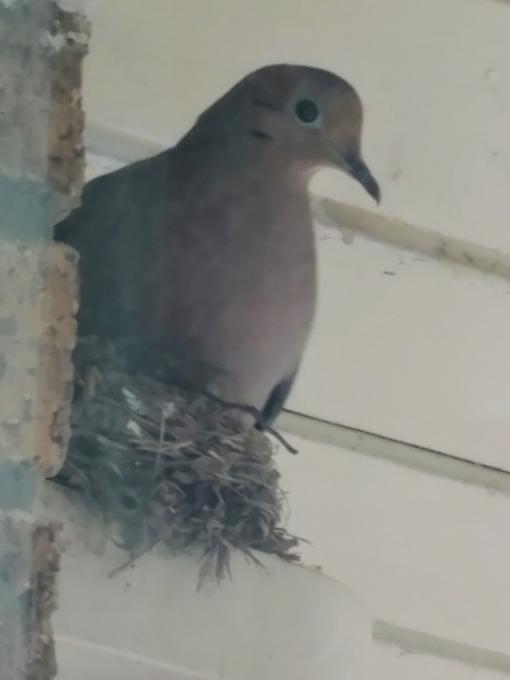
 Among the many species I see at my feeder, the Mourning Dove is a favorite of mine. They are so laid back and gentle as they nibble on the seed or just resting in the sun! As you can see in the first picture, they built a nest on top of our porch light and were not skittish as I came and went through the door. I enjoyed watching at the time the eggs hatched and the little ones being fed!
Among the many species I see at my feeder, the Mourning Dove is a favorite of mine. They are so laid back and gentle as they nibble on the seed or just resting in the sun! As you can see in the first picture, they built a nest on top of our porch light and were not skittish as I came and went through the door. I enjoyed watching at the time the eggs hatched and the little ones being fed! 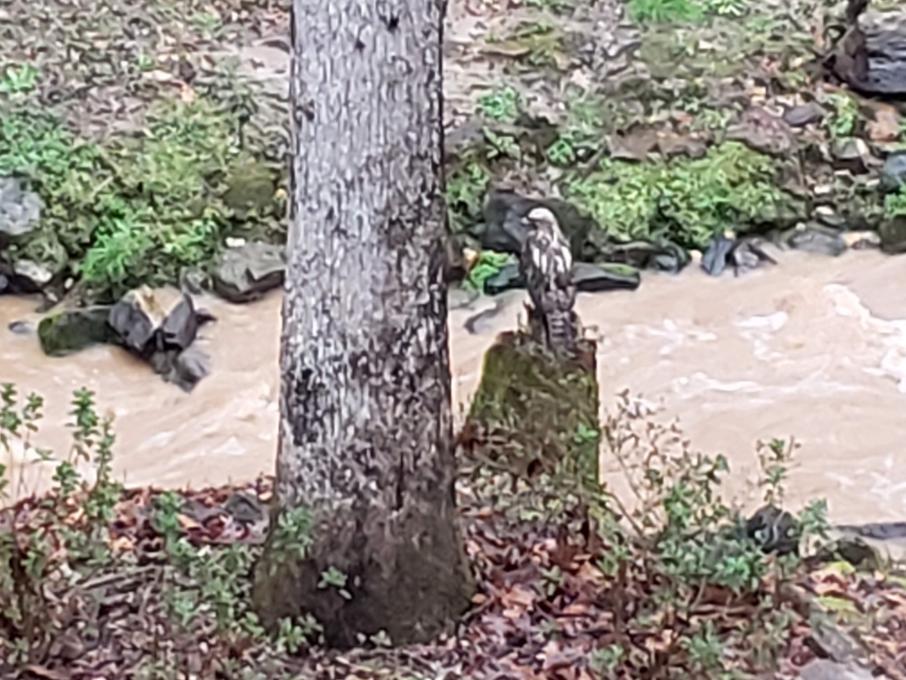
 This is a Kingfisher. Sorry for the poor quality of the photo. I believe it is a female because of the rusty-colored belt. I'm not sure what group they belong to. I'd say either waterfowl or wading birds, but they don't have webbed feet or long legs! If anyone knows, I'd love to be informed.
This is a Kingfisher. Sorry for the poor quality of the photo. I believe it is a female because of the rusty-colored belt. I'm not sure what group they belong to. I'd say either waterfowl or wading birds, but they don't have webbed feet or long legs! If anyone knows, I'd love to be informed. 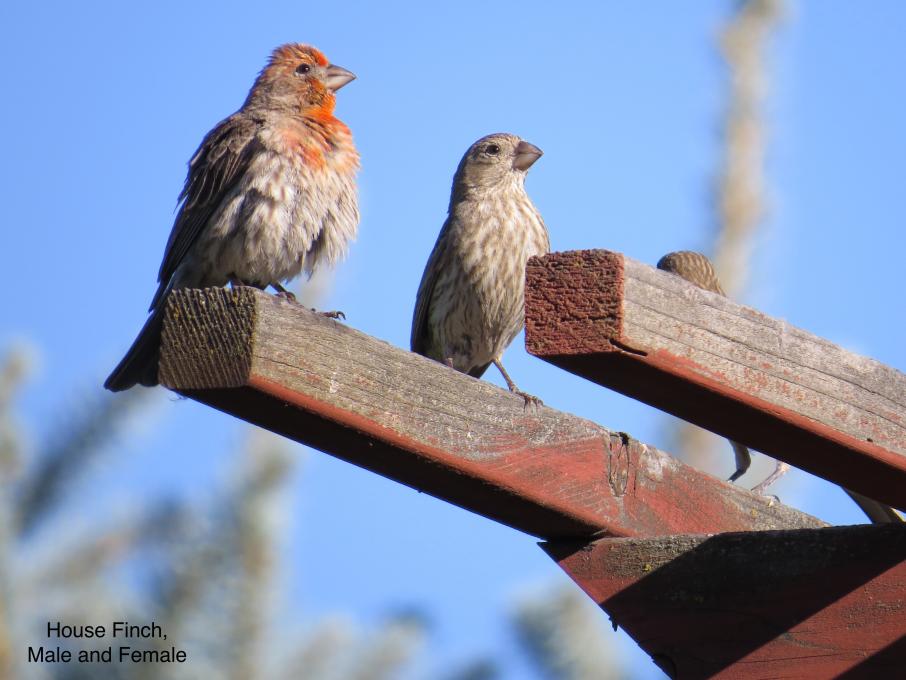
 I love woodpeckers! This was taken today 4/22/2020 in my yard in northeasy Ohio. He's been visiting every day for the past week.
I love woodpeckers! This was taken today 4/22/2020 in my yard in northeasy Ohio. He's been visiting every day for the past week. 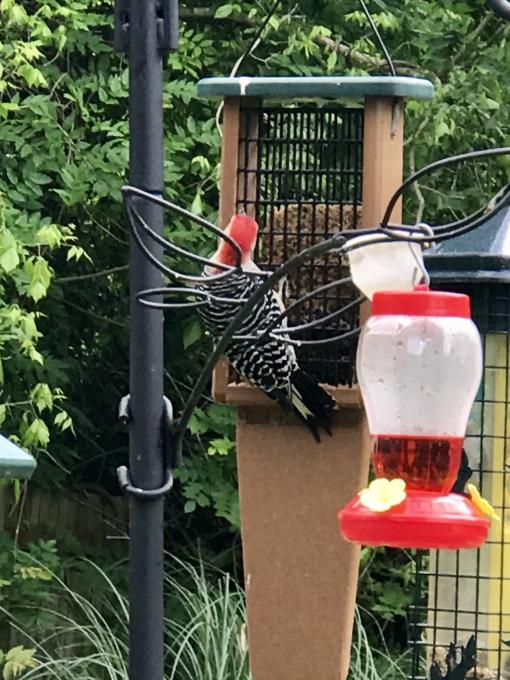
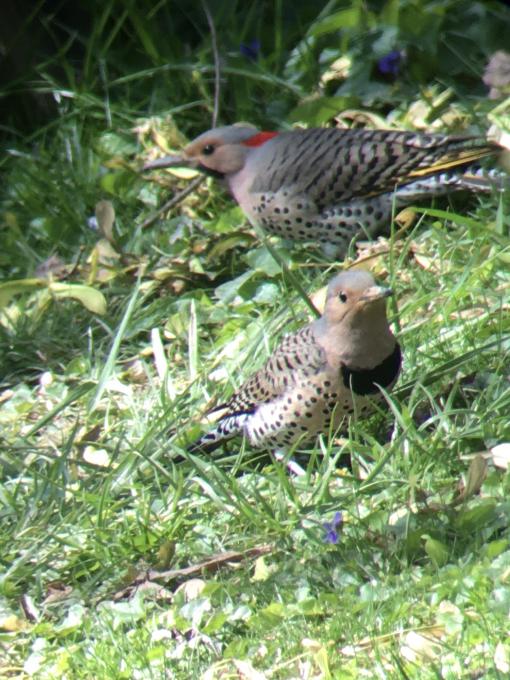 Songbirds/Finches and buntings: a Northern Cardinal pair (female in front, male in back). Spring is truly in the air as a number of pairs seem to be competing for a “top spot” in the yard!
Songbirds/Finches and buntings: a Northern Cardinal pair (female in front, male in back). Spring is truly in the air as a number of pairs seem to be competing for a “top spot” in the yard!
 Songbirds/Other: a Blue Jay pair (I’m not sure of the sex… but I like to imagine one of each). The Blue Jay didn’t fit nicely into the course’s Songbird categories, but I looked on AllAboutBirds and see that they belong to the crow family (Corvidae).
Songbirds/Other: a Blue Jay pair (I’m not sure of the sex… but I like to imagine one of each). The Blue Jay didn’t fit nicely into the course’s Songbird categories, but I looked on AllAboutBirds and see that they belong to the crow family (Corvidae).


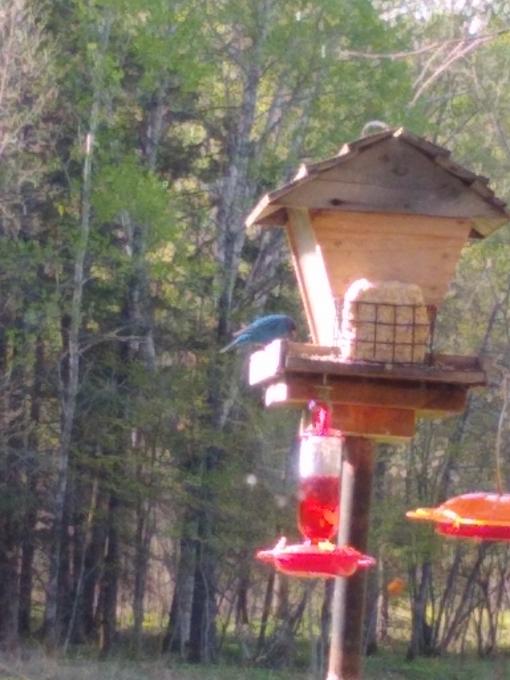 I believe this is an Indigo Bunting? It appeared at my feeder last summer. I am fascinated by the variety of birds that come to my feeder throughout the year. I am taking this course to help myself to identify the birds that appear. Today so far a Yellow Finch and what I believe to be a Downy Woodpecker. I have a really nice Palliated Woodpecker that likes to visit as well.
I believe this is an Indigo Bunting? It appeared at my feeder last summer. I am fascinated by the variety of birds that come to my feeder throughout the year. I am taking this course to help myself to identify the birds that appear. Today so far a Yellow Finch and what I believe to be a Downy Woodpecker. I have a really nice Palliated Woodpecker that likes to visit as well. 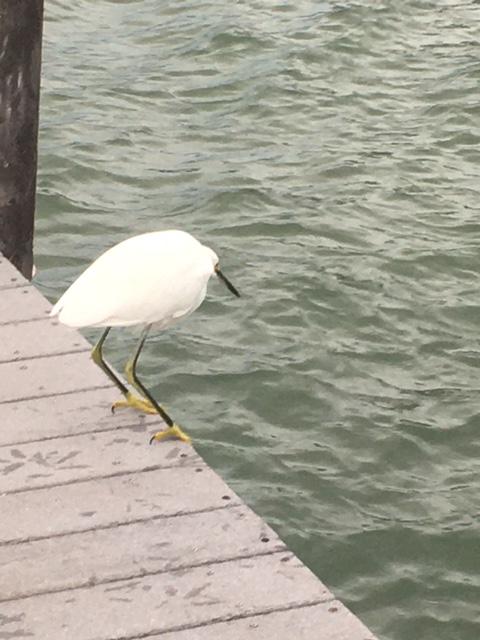
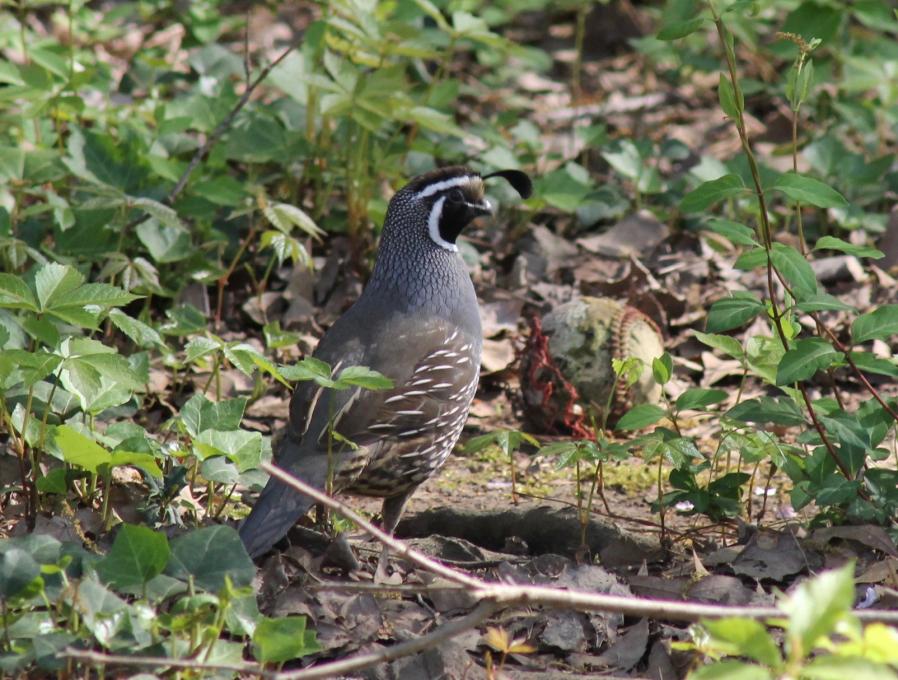 2. Songbirds/Other Songbirds?
While the Brown Thrashers is definitely a Songbird, its appearance and habit of thrashing around in the underbrush for food didn't seem to fit with any of the other subcategories that we learned.
2. Songbirds/Other Songbirds?
While the Brown Thrashers is definitely a Songbird, its appearance and habit of thrashing around in the underbrush for food didn't seem to fit with any of the other subcategories that we learned.
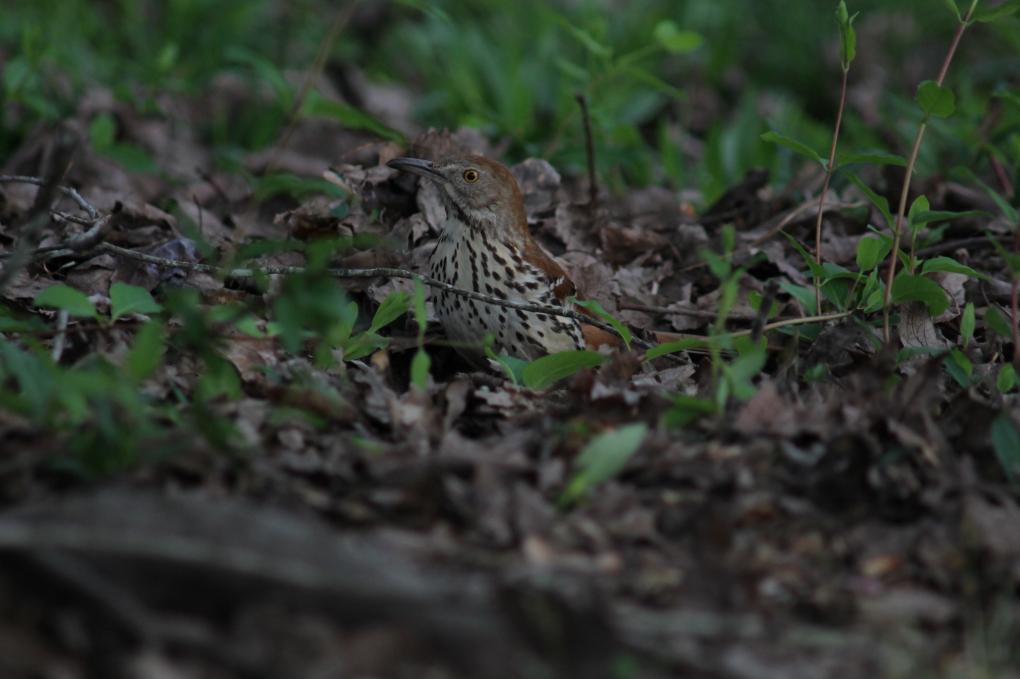 3. Songbird/ Finches and Buntings
The Northern Cardinals stout, short bill and bright colors put it in the Finches and Buntings subcategory of the Passeriformes. Beautiful birds!
3. Songbird/ Finches and Buntings
The Northern Cardinals stout, short bill and bright colors put it in the Finches and Buntings subcategory of the Passeriformes. Beautiful birds!

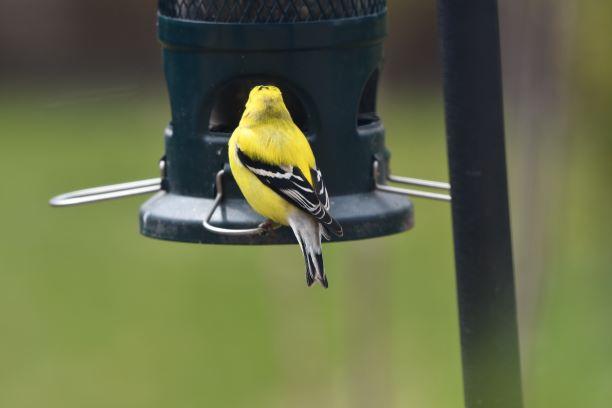

 From my Toronto backyard, the male gold finches are transitioning to their spring plumage. Here is an example of a bright male, a female, and a transitioning male, all taken on the same day.
From my Toronto backyard, the male gold finches are transitioning to their spring plumage. Here is an example of a bright male, a female, and a transitioning male, all taken on the same day.